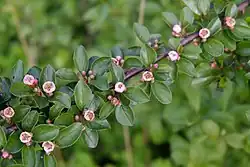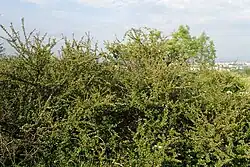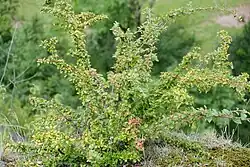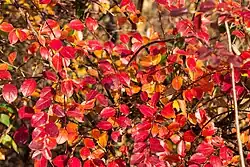Cotoneaster divaricatus
| Cotoneaster divaricatus | |
|---|---|

| |
| Flower buds | |
| Scientific classification | |
| Kingdom: | Plantae |
| Clade: | Tracheophytes |
| Clade: | Angiosperms |
| Clade: | Eudicots |
| Clade: | Rosids |
| Order: | Rosales |
| Family: | Rosaceae |
| Genus: | Cotoneaster |
| Species: | C. divaricatus
|
| Binomial name | |
| Cotoneaster divaricatus | |
| Synonyms[1] | |
|
Pyrus divaricata (Rehder & E.H.Wilson) M.F.Fay & Christenh. | |
Cotoneaster divaricatus, the spreading cotoneaster, is a species of flowering plant in the family Rosaceae.[2][3] It is native to China, and has been introduced to Ontario in Canada, the Midwest United States, northern and central Europe, Kenya, and the South Island of New Zealand.[1] A shrub reaching 1.8 m (6 ft) tall but spreading to 2.4 m (8 ft), and hardy in USDA zones 4 through 7, it is considered a valuable landscaping plant by the Missouri Botanical Garden.[2] The Centre for Agriculture and Bioscience International lists it in its Invasive Species Compendium.[4]
-
 Forming a hedge
Forming a hedge -
 In fruit
In fruit -
 Habit
Habit -
 Autumn foliage
Autumn foliage
References
- ^ a b "Cotoneaster divaricatus Rehder & E.H.Wilson". Plants of the World Online. Royal Botanic Gardens, Kew. Retrieved 9 May 2022.
- ^ a b "Cotoneaster divaricatus". Plant Finder. Missouri Botanical Garden. Retrieved 9 May 2022.
- ^ "Cotoneaster divaricatus spreading cotoneaster". The Royal Horticultural Society. 2022. Retrieved 9 May 2022.
3 suppliers
- ^ "Datasheet Cotoneaster divaricatus". Invasive Species Compendium. CAB International. 2022. Retrieved 9 May 2022.